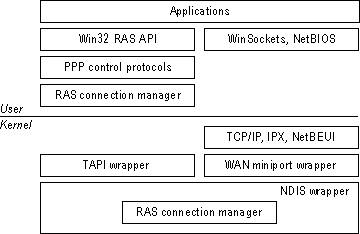
Support for ISDN is a built-in feature of Windows NT Server. ISDN requires Transmission Control Protocol/Internet Protocol (TCP/IP) and Point-to-Point Protocol (PPP), which Windows NT Server fully supports. PPP is an industry standard that enables Windows NT – based computers to support remote access networking in multivendor networks.
In addition to providing support for TCP/IP and the TCP/IP-based PPP protocols, Windows NT server architecture supports ISDN by using the services and application programming interfaces (APIs) illustrated in the following figure.

Figure 4.4 ISDN support in the Windows NT server remote access architecture
In the preceding figure, Win32 RAS API stands for the Win32® application programming interface (API) implementation of Remote Access Service. WinSockets stands for the Windows Sockets API; TAPI stands for telephony API; and IPX stands for Internetwork Packet Exchange, a transport protocol.
This architecture is important because, as previously described, internal and external ISDN adapters are differently configured and used by the Windows NT Server operating system. Internal ISDN device drivers provide network driver interface specification (NDIS) and WAN miniport device drivers. These drivers are installed when you configure the ISDN adapter by using the Adapter tab in the Network program in Control Panel.
However, external ISDN adapters are attached to the computer by using the serial (COM) port. Because of this, Windows NT Server processes an external ISDN device as a modem and as a result integrates an external ISDN device differently than an internal ISDN device.
Note
Vendors of ISDN hardware devices can obtain information about developing NDIS and WAN miniport drivers for their ISDN hardware device drivers by connecting to: http://www.microsoft.com/hwdev/devdes/isdnwin.html